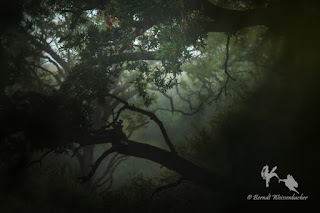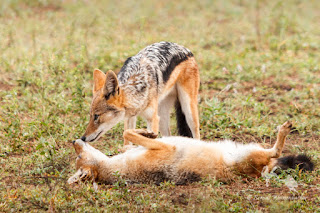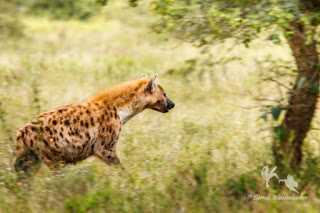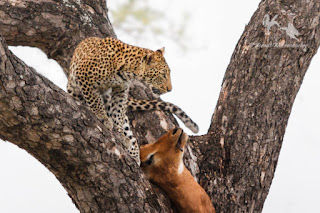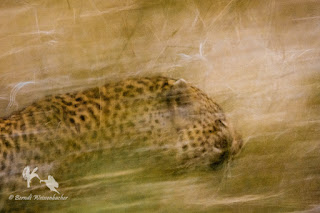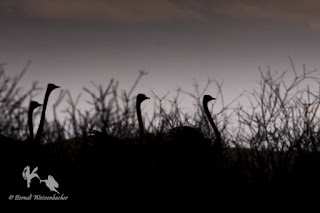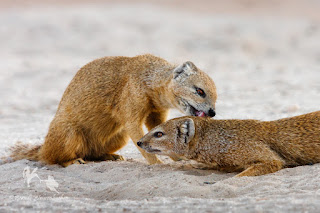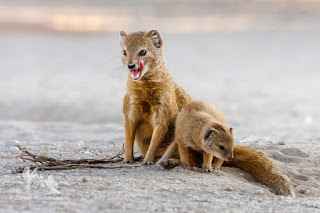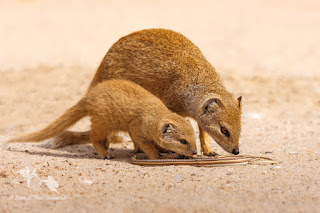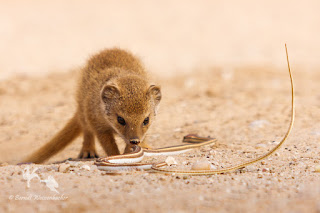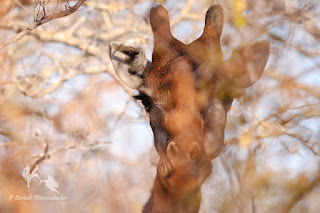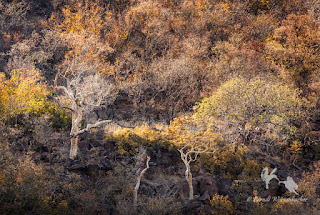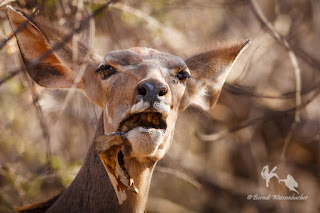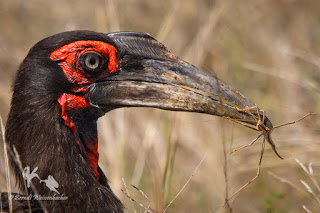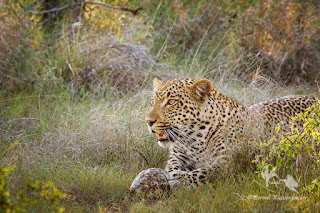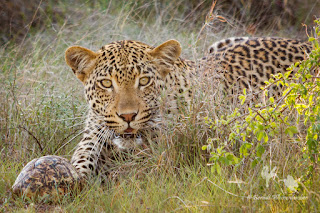Whenever I visit the Kruger National Park, South Africa, or any other destination for that matter, bad weather will accompany me. It has become standard upon my return for my family and friends to ask, “How many days of rain did you experience?” (They have suggested that there may be a lucrative future for me as a rainmaker – I know my own luck though, and the day I set forth to bring rain to parched areas of the subcontinent, the bad weather will leave me high-and-dry.)
Jacqui and I had spent a week and a half with incessant rain and skies blanketed in thick grey clouds at Tamboti Camp near the western border of Kruger. Despite the bad weather, our stay at Tamboti had so far been delightful – as any time spent in Kruger always is. I had kept busy with photography throughout, focussing especially on the antics of a resident pair of black-backed jackals that kept me occupied for a large part of our stay. So far, however, the wet weather had kept the larger predators skulking in thick bush – not a tail, not a whisker, had been sighted on this trip.
I avoid long trips on photographic adventures. I travel an average of between 10 to 20 kilometres in the early morning and a similar distance in the late evening. Midday hours are invariably spent in camp. However, on this occasion I relented – it was the last full day we were to spend in the park and we were in desperate need of some supplies (tea and tobacco, as one of my favourite songwriters sings). I decided that a day trip to a different part of the park, albeit in near-constant drizzle was necessary and bearable.
The tar road between Tamboti and Satara camps is just over 50 kilometres long, a good three hour drive excluding any time spent at sightings of game along the way. Just eight kilometres out of camp, two massive hyaena females loped across the road in front of us at speed. They were visibly nervous – while travelling quickly, they kept on stopping to approach dense bushes with caution, heads kept low and backs kept high. On several occasions, they leapt sideways (and even backwards) from single bushes, always resuming their hasty trot across the veld almost immediately. Within minutes, they had vanished over the visible horizon. An all too fleeting, yet mesmerizing, encounter. The rest of the trip to Satara proved to be uneventful.
At Satara, we completed our necessary shopping as quickly as possible. After a mid-morning snack and a relaxing saunter around camp, we set off to head back to Tamboti just after midday. Four kilometres outside of Satara camp, the road was blocked completely by traffic. In the midst of the chaos stood at least half a dozen ‘safari vehicles’ with jeep-jocks and clients. A little further along the road from this heap, the front portion of a dead Impala ram, wedged in the fork of a tree 40 metres from the roadside, indicated what everyone was hoping to spot.
I loathe such Kruger traffic jams. Usually I wend my way through the chaos and continue driving. Revving engines, the chatter of people and the inane lectures and inevitable bad jokes of the jeep-jocks make the hairs on this old dog's neck rise. However, on this one occasion, we decided to hang around. We had dipped out on cats this trip, it was drizzling and we were heading home the following morning. It took me a while to manoeuvre through the knot of vehicles. Once we had left the gridlock behind us, I picked a spot from which we could watch the tree at some distance away from the rumpus. Let's give it an hour.
The coffee (tea for Jacqui), rusks and tobacco had relaxed me. I forgot about time. Now and then shouts from the knot down the road indicated that someone had seen the flick of an ear, the twitch of a whisker, among the dense shrubs and tall grasses. Suddenly the traffic jam roared into life; engines revving, hooters tooting, it came hurtling towards Jacqui and my parking spot. Within half a minute 30 or more cars had engulfed us.
With that, a leopard cub started hauling itself up the vertical trunk of the tree. The effort to do this was massive for such a young animal. At times the cub stuck to the side of the tree-trunk like a flat wall-spider to a rock. The cub made the climb and started sniffing and licking at the dead impala ram whose tongue was still protruding from between tightly clenched lips. All youngsters love to play and this leopard cub fitted the mould perfectly. As if used to star performances, the cub strutted along the big boughs, staring out at the bushveld while standing or perching, then circling its prey at some distance. After a few minutes the cub’s performance was complete – it slipped down the trunk of the tree and vanished.
I turned to look at Jacqui. The delight at her first sighting ever of a young leopard was obvious – her eyes switched from expressions of deep thought to squints of inner laughter. Jacqui then looked at her watch. “You know we have just over an hour to get back to camp?”
It took me more than a quarter of an hour to navigate through the tangle of steel that had surrounded us. This left exactly the time required to get back to Tamboti at the maximum speed limit allowed. I had broken the rules of photographic outings and would now have to travel in a manner that I did not agree with – speeding through a most magical park at 50 kilometres per hour during the last hour of the day. I was disgusted with myself. To make matters worse, the light was fading rapidly because of the dense cloud cover. There was no time for game watching or sightseeing. Both Jacqui and I peered straight ahead into the gloom that stretched out in front of us, concentrating on every dark blob and blotch beside the road, knowing that at the speed we had to travel and in this light an elephant stepping into the road would prove disastrous.
Eight kilometres from camp, as we slid over a rise, the car’s headlights picked up a shape on the road. A very large male leopard sauntered along in the same direction we were travelling. I slowed immediately, allowing the leopard to move at his own pace. As we neared, he decided to head into a thick clump of grass.
I stopped the vehicle some 15 metres ahead of the leopard and set up my camera. I knew from experience that I had an extremely slight chance of making the shot. I knew too that if I could pan the camera at a very low shutter speed (1/5th of a second in this case) and track exactly the movement of the beast, the dense grass in front of the leopard would be blurred to non-existence. With a bit of luck leaving an outline of the beast sufficiently well-defined on the exposure. I took five shots – only one proved useful in the end: ‘Death in the Long Grass’.
We made it to camp just on time, despite the five-minute stop for this most majestic of old hunters. Never again have I travelled like this.
